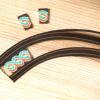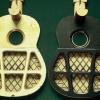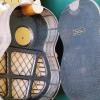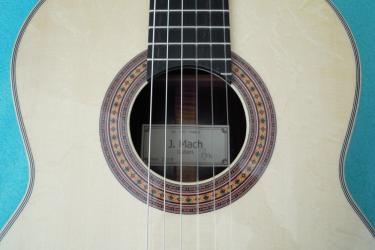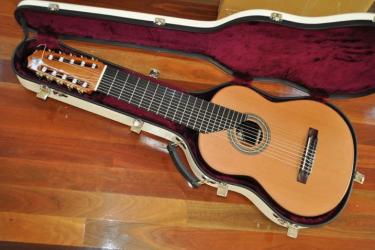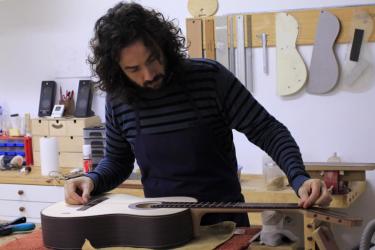
I’m delighted to have Nicholas Scott from Derbyshire, UK.
Q1. Could you please tell us a little about your luthiery and its history?
Been making since 1985, mainly classical, but had a 5 year period of steel strings. Making Smallman type classicals exclusively since 1996.
I'd been making traditional fan braced classicals for about 10 years; according to one of the more outspoken London dealers they were 'OK, but nothing special'. It was a realistic assessment, but then again you could say the same of most of the high end stock found in the shops at the time.
But then I went to a recital given by Craig Ogden, where he would be playing one of those odd Australian guitars that were ridiculed by so many people. "Built like a tank!" was a comment from a dealer who I knew at the time.
And perched on the front row - where you had to be if you wanted to hear a guitar - my expectations were low. To liken the experience to that of Saul on the Damascus road would be an overstatement - but not by much. I certainly didn't fall off my donkey, but I had to sit on the back row for the second half, so overwhelming was the sound. Playing this Smallman guitar in a domestic environment a few hours later was just as overwhelming, and now I could easily compare it with a couple of my own instruments as well as with some world famous names that were to hand.
My technique is mediocre at best, and my nails are pre-disposed to give a thin sound, but I could make a fat, round juicy sound with very little effort. No longer did I feel inadequate and embarrassed with my usual feeble sound. This guitar could change the way I felt about the very act of music making, and nothing I'd ever played previously had done that.
Measuring the action of this guitar showed it to be ludicrously high, yet even a wimp like me found it so easy to play. The instrument seemed to break all the rules commonly accepted, but in truth I had no real idea at that moment just how radical and revolutionary the Smallman design was.
The guitar world had assumed that Smallman's big innovation was the balsa/carbon lattice bracing system on the soundboard, and that it was this that gave him his unique sound. But Greg Smallman tells it very differently..... he had been building conventional guitars and varying the bracing patterns, but no matter which pattern he tried, the guitars all seemed to sound the same.
He recalled the famous ' papier mache ' experiment by Torres, in which the back and sides were made from laminations of cardboard, and the oddity that no one seemed to know what the conclusion was..... so he did his own version of the Torres experiment. But instead of cardboard, he went in the opposite direction and used a really thick dining room table for the back. The sides were cut out of a solid block formed from laminations of the rest of the table. It was so solid you needed two hands to pick it up. To this he added a conventional soundboard.
To his surprise, this produced a much better sound with a very different character to all his previous instruments, but at first he did not know exactly why.

Eventually he realised that the string tension acting on the bridge was also pulling the bottom half of the soundboard towards the top half - see diagram. With nothing to stop this force, and because of the curved shape of the bottom half of the guitar, the sides are pushed outwards.
So you have compression of the soundboard in the longitudinal direction, but expansion in the lateral direction. These competing forces prevent the soundboard from vibrating efficiently, and also provide - for the first time - a logical explanation for the guitars tendency to lose its potency with age and for the soundboard to split at the least little provocation.
You can see these forces for yourself by marching into your kitchen and seizing the first plastic bowl or bucket you see. Press one edge of it - and notice how the edges to the left and right move outwards. Compression in one direction produces expansion in the other.
So, quite by accident Smallman had solved this problem with his monstrously thick back and sides , but he realised that a better solution was an internal frame tailored to resist those forces. With this in place, he then tried different soundboard bracing strategies before settling on the balsa/carbon he has since become famous for.
Q2. Please describe your idea of a good sounding guitar, and what you do to achieve it?
Since I aim to recreate the Smallman sound, a good guitar ( for me ) should sound like one.
When Greg Srmallman came to London in the summer of 2004, he described exactly what his sound objective was....
- A full sound, not thin, characterised by a strong fundamental note with lots of lower overtones.
- Large tone colour range, together with 'vowel' sounds. These vowel sounds are the 'aaaah' and 'ehhhhh' character that appear to be unique to the Smallman guitar, and give the instrument a real voice and presence which is completely lacking in the traditional guitar sound. This is often the very first quality that strikes the listener ; that, and the fact that you can actually hear the thing in a concert hall.
- Not percussive. A note that reaches its maximum volume slightly later than usual but decays less rapidly will give an impression of much more fullness.
- Large dynamic range - but with same sound. With other guitars, the sound character changes dramatically when you try to play loudly. With the Smallman it doesn't. John Williams demonstrated this at the London event, and said that for him, this character is the one he values the most.
- Sympathetic resonance from the bass strings. Again, this contributes to the 'full' sound. It should be noted though, that some guitarists positively hate the bass strings singing along when playing a melodic line on the top string.
- Responsive to input. I don't think that anyone would argue with this one.
Q3. Please tell us about your idea of improving playability, and what you do to achieve it?
Smallman type guitars are much easier to play than the conventional type, so I am not looking for solutions to problems I don't have.
Q4. Please tell us your opinion about the traditional finishing method (French polish) and new methods (lacquer, catalysed finishing, etc).
I think it's a shame that guitarists have been mislead for so long about this aspect of construction, but people seem to love propagating myths, mystique and folklore about even the most mundane matters. And varnish appears to be top of the list for most folk, with magical bracing patterns running a close second.
For a perspective from a world class luthier you could do no better than read what Jose Ramirez III had to say on the subject in his book 'Things about the guitar'.
Greg Smallman uses an acrylic varnish on the soundboard so thinly that you can't even buff it up to a shine afterwards. When asked why he didn't pursue the Holy Grail of French polishing, he replied that it (shellac) was too thermoplastic a substance - it softens in warm weather, and a soft substance will absorb and dampen the sound.
For myself, I've used -
- Two pack polyurethane - 2 years
- French polish (shellac) - 7 years
- Oil finish - mainly linseed - 1 year
- Urea formaldehyde melamine - 17 years
- and have recently wasted waaaaay too much time with acrylic waterborne lacquers trying to make them work.
I'm not in love with any of them; none of them have any magical properties whatsoever.
They all have peculiarities that must be understood and accommodated. Nearly forgot - you don't see that old favourite nitrocellulose lacquer on my CV because I'm not ideally set up for spraying, and the stuff demands it.
To conclude I'll just say this, if you ever get the chance to sit down and play a real Smallman guitar , the last thing you'll be thinking of is the type of varnish he used.
Q5. Please tell us your opinion regarding shorter-scale guitars such as 640, 628 and 615mm in terms of playability, design, sound quality and volume. Is there an increasing need to cater to smaller-handed or female players?
I think there is much more to be gained by reducing the width of the fingerboard rather than shortening the scale length.
Q6. Many readers say they end up being very confused after trying many guitars. Could you give us some advice on how to examine the guitars' sound quality and playability at a shop or luthier, from the guitar-maker's point of view?
I sympathise with anyone struggling to evaluate a guitar, regardless of the environment. It does get easier with experience, but if you don't have much - and teachers are often clueless -a good place to start is the guitars ability to carry a melodic line on the first string. If it doesn't sing here, with no dead spots in the response, move on to something else.
Q8. How does the increasing rarity of some woods, rosewood for example, impact on your methods, and the quality of the end product?
The Smallman type guitar does not require the use of any particular species of timber for the back and sides. You could use almost anything. I have been using Ziricote for the last 10 years simply because it looks so much nicer than the available rosewoods.
Q9. How do you see the future of this beautiful tradition in the 21st century?
My specialist subject is only guitar making. Speculating on the future is beyond my skills.

